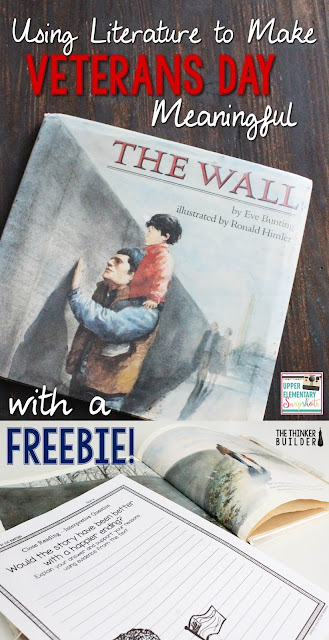 With a meaningful holiday like Veterans Day, how do you find ways to give it the time it deserves? It's especially difficult when your days are already packed full of curriculum and standards, and maybe you're two lessons behind the rest of your grade level and possibly on the verge of ripping up the scope and sequence you taped to your filing cabinet back in August.
With a meaningful holiday like Veterans Day, how do you find ways to give it the time it deserves? It's especially difficult when your days are already packed full of curriculum and standards, and maybe you're two lessons behind the rest of your grade level and possibly on the verge of ripping up the scope and sequence you taped to your filing cabinet back in August.My favorite way to dig into holidays like Veterans Day is with an excellent piece of literature. You can work it right into your literacy block, and with a little planning you can still tie in the literacy standards you need so you don't feel like you are falling further behind.
For Veterans Day, I love using Eve Bunting's The Wall.
It's a simple story, beautifully written (and beautifully illustrated by Ronald Himler), about a boy and his father who visit the Vietnam Veterans Memorial in Washington D.C. to honor the boy's grandfather who died in the Vietnam War.
Whether used as a jumping off point into a week long unit, or a single read-aloud and discussion, it's my favorite book for Veterans Day.
Here's how you might use the book with your class:
Gather your kids around and talk a bit about Veterans day, what a veteran is and why we honor them on this day. You might invite students to name veterans whom they know personally. Then introduce the book to students.
Read the story to your class. Read it slowly, pausing often for students to really take in the pictures and think about the words.
Upon finishing, ask students to share their thinking, their feelings. Ask them if they made any personal connections. If you have ever been to Vietnam Veterans Memorial, tell them about it.
Eventually, funnel the discussion to this single discussion question: Would the story have been better with a happier ending?
Before inviting responses, you might trigger some additional thought with some of your own elaboration, like, "Boys and girls, we are so used to reading stories with a happy ending. We come to expect it from the books we read and movies we watch. A happy ending leaves us satisfied; it gives us a warm and fuzzy feeling inside. So I ask you again, would The Wall have been better if it had a happier ending?"
Just prior to opening the floodgates, look back at the book with students and reread the last two pages of text.
Now act as a facilitator with the ensuing discussion. Urge students to look at the question from all sides, to listen and respond to their classmates, and to refer back to the text to support their thinking.
Use these follow-up questions to help the discussion snowball:
- How happy was the ending?
- Was it happy for anyone? The dad? The boy? The boy's grandpa in a way?
- Was it happy at some other point in the story?
- If not happy, what words do describe the ending?
- Is it fair to describe the ending (or the whole story) with just one word?
- Was it a good ending? Surprising? Appropriate?
- Can a story still be good without a happy ending? Can it be good if none of the story is happy?
- So what makes a story good?
- Do you think the author tried to make the ending happy?
Try not to get in the way too much during the discussion. While most students pick up on the somber tone of the story and the wistful last thoughts of the boy, keep pushing them further, eventually bringing the discussion around to Veterans Day as a whole and how it should be observed.
After the discussion, you might want to highlight some of the important points made by students, jotting them down on the board. Then have students bring together their thoughts into a written response. Make the book available for reference, encouraging students to refer to portions of the text to support their thinking.
Click the image above to grab the written response sheet that goes along with the discussion.
Take The Wall further with my literature unit. It's full of engaging and informative activities, like vocabulary posters and story work like "Inferring Deeper Meaning." It also includes an informational article called "The Story Behind the Wall," as well as a PowerPoint I made called "Where Is The Wall?" that takes students to Washington D.C. and zooms into the location of the Vietnam Veterans Memorial and explores some of its design features.
One of the unit's extensions has students design a new Veterans memorial for their community.
And to wrap up the unit, students honor veterans with a special note of appreciation.
Click the image below for more information about my literature unit for The Wall.








